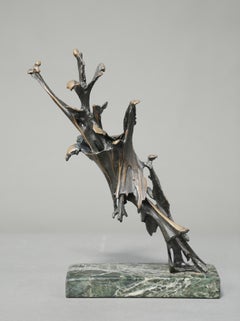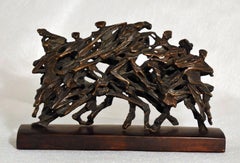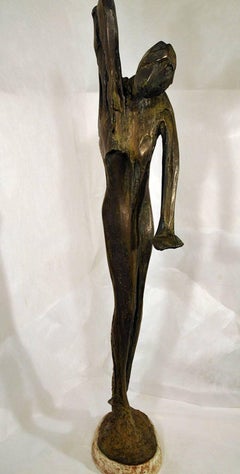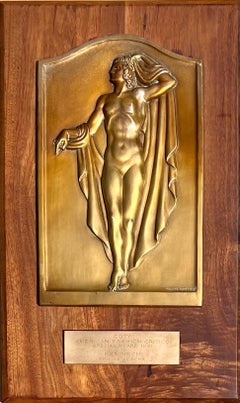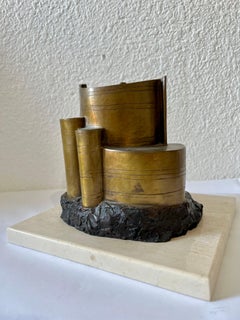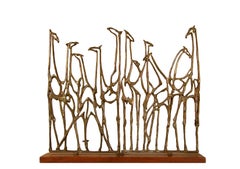Robert Cook Art
to
2
1
Overall Width
to
Overall Height
to
3
1
1
2
1
2
2
2
2
1
1
3
3
2
1
4
7,736
4,946
2,504
1,373
3
Artist: Robert Cook
Splash
By Robert Cook
Located in Greenwich, CT
Robert Cook’s Splash sculpture draws inspiration from the iconic photograph of a drop of milk creating a circle and splash in a pool of milk. This fleeting moment of suspended motion sparked Cook’s exploration of how to capture such dynamic energy in a static form.
Robert Cook was a great American sculptor and his works are in many museums and his iconic Dinoseras piece commands a spot on the street of New York at 51st Street.
Important to note with this work that it is unique and there are no other casts. Cook sculpted in wax and when he cast this destroyed the wax and there was no mould. Very few sculptors work in this manner and it speaks to a very pure and altruistic form of sculpture. If perhaps he had been more commercially minded he would have done large editions but instead he valued singularity as in nature.
In Splash, Cook freezes a moment of kinetic energy, capturing the elegant tension between impact and expansion. The sculpture embodies both grace and chaos, with a fluidity that suggests movement at the very instant it’s frozen in time. Cook’s mastery of his medium allows this dynamic moment to be immortalized in bronze, creating a powerful and emotional resonance that transcends the physical form, making Splash both a formal and philosophical exploration of time, space, and motion.
Signed: R Cook...
Category
1960s Abstract Robert Cook Art
Materials
Stone, Bronze
Harlem III
By Robert Cook
Located in New York, NY
Signed, titled, and dated in ink on base verso. Unique sculpture created using the lost wax process. This piece is 7 1/2" high x 12" wide x 3 1/2" deep.
Robert Cook was born in Boston in 1921. He studied with George Demetrios...
Category
1990s Modern Robert Cook Art
Materials
Bronze
Up
By Robert Cook
Located in New York, NY
Bronze, 1967. Height 59" (149.9 cm) width max 15" (38 cm).
Signed on base "R Cook." This unique large sculpture was made using the lost wax process.
“ ...
Category
Mid-20th Century American Modern Robert Cook Art
Materials
Stone, Bronze
Related Items
1961 Coty Award Plaque Kenneth Hairdresser Jacqueline Onassis Bronze Fashion
Located in New York, NY
1961 Coty Award Plaque Kenneth Hairdresser Jacqueline Onassis Bronze Fashion
Bronze on wood. The wood plaque measures 12 3/4" by 20 3/4 inches. The bronze plaque itself is 13 3/4 x 8 3/4 inches and the the bronze inscription, which reads "COTY, American Fashion Critics Special Award 1961 to KENNETH of LILY DACHE...
Category
1960s American Modern Robert Cook Art
Materials
Bronze
Bronze Abstract Space Age Book Sculpture LA California Modernist Charna Rickey
By Charna Rickey
Located in Surfside, FL
Charna Rickey 1923 - 2000 Mexican-American Jewish Woman artist.
Signed Bronze House of Books, Architecture Bronze sculpture, signed Charna Rickey and on the front "House of the book." It depicts an open Torah. Original patina.
Approx. dimensions: 7 in. H x 9 in. W x 8.5 in. D. Weight: 13.1 lbs.
Modernist Judaica Sculpture
Born Charna Barsky (Charna Ysabel or Isabel Rickey Barsky) in Chihuahua, Mexico, the future artist lived in Hermosillo and immigrated to Los Angeles when she was 11. She was educated at UCLA and Cal State L.A., she married furniture retailer David Rickey and explored art while raising their three daughters. Moving through phases in terra cotta, bronze, marble and aluminum, she found success later in life. Rickey became one of the original art teachers at Everywoman's Village, a pioneering learning center for women established by three housewives in Van Nuys in 1963. She also taught sculpture at the University of Judaism from 1965 to 1981.
As Rickey became more successful, her sculptures were exhibited in such venues as Artspace Gallery in Woodland Hills and the Courtyard of Century Plaza Towers as part of a 1989 Sculpture Walk produced by the Los Angeles Arts Council. Her sculptures have also found their way into the private collections of such celebrities as Sharon Stone.
Another of Rickey's international creations originally stood at Santa Monica College. In 1985, her 12-foot-high musical sculpture shaped like the Hebrew letter "shin" was moved to the Rubin Academy of Music and Dance at Hebrew University in Jerusalem. The free standing architectural Judaic aluminum work has strings that vibrate in the wind to produce sounds. Rickey also created art pieces for the city of Brea. They commissioned some amazing art pieces by Laddie John Dill, Walter Dusenbery, Woods Davy, Rod Kagan, Pol Bury, Niki de Saint Phalle, Magdalena Abakanowicz, Larry Bell, John Okulick...
Category
20th Century American Modern Robert Cook Art
Materials
Marble, Bronze
Abstract Modernist Armless Female Nude Torso Bust Bronze Sculpture
Located in Houston, TX
Modernist nude bronze sculpture by Houston, TX artist David Adickes. The sculpture depicts an abstract armless female nude torse that stands on a wooden base. The piece is signed by the artist at the back of the sculpture's left leg.
Artist Biography: Born (1927) and raised in Huntsville, TX, David Adickes is an artist whose art and heart are closely aligned with Paris, France. After studying art at the Atelier F. Leger in the late 40s, Adickes burst onto the art scene in Houston and elsewhere in the early 50s and has been a prominent member of Houston’s art community ever since. While his most visible works are his giant sculptures, from the Virtuoso in downtown Houston...
Category
Early 2000s Modern Robert Cook Art
Materials
Bronze
Hunter, Bronze and Wood Sculpture by James McCain
By James McCain
Located in Long Island City, NY
Artist: James McCain, American (b. 1944)
Title: Hunter
Year: circa 1980
Medium: Bronze Sculpture on Wooden Base, signature and numbering inscribed
Edition: 85/250
Size: 12.5 x 6 x ...
Category
1980s American Modern Robert Cook Art
Materials
Bronze
Bronze Architectural Model Sculpture Tempio Bretton Architecture Maquette
Located in Surfside, FL
TEMPIO BRETTON: from the catalogue MONUMENTA, 19th International Sculpture Biennale, Antwerp, Belgium.
Tempio Bretton was created in homage to the celebrated English landscapist Capability Brown for the occasion of an exhibition at Bretton Hall in the Yorkshire Sculpture Park , a park in the style of the great master of English garden design. The inclusion in the English garden of a temple ruin, or "eye-catcher," (architectural folly) was used to draw the eye and mind to a focus in time and space, present the beholder with an immediate relationship to an historic past made new within his or her own surroundings, and create a depth of space never before seen in garden design.
I took the idea of the temple ruin eye-catcher and reduced it to a scale at the point where architecture and sculpture merged. Tempio Bretton is not capacious enough to walk into, yet it is considerably larger than a man.
One view of it presents a knot of golden columns clustered together, topped by a dome shape. The only clue from this side to the temple's non-conformity to historic principle is a sharp notch cut into the square base.
Viewed from the opposite side, the cluster of columns capped by an angular top opens up as if to welcome someone in, yet the mysterious core is still impenetrable. These contradictions articulate a confrontation between past and present, and an exciting truth. The past is always at the heart of our constructions in the present.
Walter Dusenbery (born September 21, 1939 in Alameda, California) is an American sculptor. He attended the San Francisco Art Institute, earned an MFA from California College of Arts and Crafts, and then studied in Japan and Italy under Isamu Noguchi. He also held teaching positions at Harvard University and University of California, Berkeley Graduate School of Design. From 1971 to 1988, he lived both in Pietrasanta,Italy, and in Little Italy, New York City. Dusenbery's preferred material is stone, particularly travertine or granite. Dusenbery has a particular interest in adding sculpture to public places, such as federal buildings, to humanize the space, but in 1988, he assembled a show of small, entirely hand-carved alabaster sculptures, called "Walter Dusenbery, The Personal Side," at the Fendrick Gallery in Washington, D.C.. In 1977, Dusenbery created Pedogna, on permanent loan from The Metropolitan Museum of Art to Landmarks, the public art program of The University of Texas at Austin.
That same year, 1988, he was awarded a large commission for the Fulton County Building Atrium in Atlanta, Georgia. The commission was for three fountains and related structures over three stories in height, designed for informal and ceremonial public events, Limestone, marble, granite and travertine fountains, pavilions, seating and meeting areas, performance and concert platforms, staircases and planters for hanging gardens. After completion of the "Atlantacropolis," Dusenbery withdrew from the gallery world and focused his energy on site-specific commissions. (like the landscape works of Maya Lin and Beverly Pepper) Seeking a large-scale stone studio for projects closer to home, he discovered there were none. In 1995, he approached sculptor and patron of sculpture J. Seward Johnson Jr. with the idea of creating a state-of-the-art stone-carving studio, so that American sculptors would not have to travel abroad to realize their work. Johnson agreed to fund such a facility, if Dusenbery would direct it. In 1996, Dusenbery designed the facility for the Stone Division at Johnson Atelier Technical Institute of Sculpture, and was its first director. The facility was situated in "a building resembling an airplane hangar," The studio offered the ability to digitally scan three-dimensional forms. The Stone Division was a success and attracted a strong group of sculptors: Magdalena Abakanowicz, Lawrence Argent, Barry X Ball...
Category
20th Century American Modern Robert Cook Art
Materials
Bronze
H 12.5 in W 3.5 in D 3.5 in
Sydney Kumalo Bronze Minimalist African Modernist Sculpture Figural Female Nude
Located in Surfside, FL
Sydney Kumalo. Features a bronze stylized female figural form sculpture fixed to a marble plinth and wood base. Bears signature on base. Measures 9 1/2" x 4 1/4". There is no edition number on the piece.
Sydney Kumalo (1935 - 1988) was born in Sophiatown, Johannesburg, on 13 April 1935. His was one of the families who had to move out of the "white" city to the South Western Townships, or Soweto. Raised in Diepkloof and educated at Madibane High School, he took with him from old Sophiatown the curious and diverse heritage of its heyday. Art classes in the Catholic school, "Sof' town" blues and jazz, the vibrant street culture and growing defiance of its population of various races who were gradually forced out into separate race-group areas. So it was that these various aspects of his early life created for Kumalo a cultural mix of a Zulu family related to the traditional royal house; city schooling, nascent township music and lingo; growing urbanised political defiance and the deep-rooted Zulu pride and respect for the legends and ancient stories of a tribal people. This mix of old and new cultures was reinforced when he began his studies at the Polly Street Art Centre in 1953 where he became a member of Cecil Skotnes group of serious artists who were encouraged to acquire professional skills. Skotnes introduced a basic training programme with modelling as a component, which marked the introduction of sculpting (in brick-clay) at Polly Street.
Kumalo was Skotnes’ assistant at Polly Street from 1957 to 1964, and having recognised his great talent as a sculptor, Skotnes encouraged him to become a professional artist.
After Kumalo’s very successful assistance with a commission to decorate the St Peter Claver church at Seeisoville near Kroonstad, with painting designs, sculpture and relief panels in 1957, Skotnes arranged for Kumalo to continue his art training by working in Edoardo Villa ’s studio from 1958 to 1960. Working with Villa, he received professional guidance and began to familiarize himself with the technical aspects of sculpting and bronze casting. In 1960 he became an instructor at the Polly Street Art Centre.
Kumalo started exhibiting his work with some of the leading commercial Johannesburg galleries in 1958, and had his first solo exhibition with the Egon Guenther Gallery in 1962. He was a leader of the generation who managed to leave behind the forms of African curios, reject the European-held paternalism which encouraged notions of "naive" and "tribal" African art, and yet still hold fast to the core of the old legends and spiritual values of his people. He introduced these subjects into his bronze sculptures and pastel drawings, evolving his own expressive, contemporary African "style".
Together with Skotnes, Villa, Cecily Sash and Giuseppe Cattaneo, Kumalo became part of the Amadlozi group in 1963. This was a group of artists promoted by the African art collector and gallery director Egon Guenther, and characterised by their exploration of an African idiom in their art. Elza Miles writes that Cecil Skotnes’ friendship with Egon Guenther had a seminal influence on the aspirant artists of Polly Street: “Guenther broadened their experience by introducing them to German Expressionism as well as the sculptural traditions of West and Central Africa. He familiarised them with the work of Ernst Barlach, Käthe Kollwitz, Gustav Seitz, Willi Baumeister and Rudolf Sharf.” It is therefore not surprising that some of Kumalo’s sculptures show an affinity with Barlach’s powerful expressionist works. Guenther organised for the Amadlozi group to hold exhibitions around Italy, in Rome, Venice, Milan and Florence, in both 1963 and 1964.
Kumalo’s career took off in the mid 1960s, with his regular participation in exhibitions in Johannesburg, London, New York and Europe. He also represented South Africa at the Venice Biennale in 1966, and in 1967 participated in the São Paulo Biennale.
EJ De Jager (1992) describes Kumalo’s sculpture as retaining much of the “canon and formal aesthetic qualities of classical African sculpture. His work contains the same monumentality and simplicity of form.” His main medium for modelling was terra cotta, which was then cast in bronze, always paying careful attention to the finish of both the model as well as the final cast. He began casting the pieces he modelled in clay or plaster into bronze at the Renzo Vignali Artistic Foundry in Pretoria North. He worked throughout his life with its owners, the Gamberini family, and enjoyed learning the technical aspects of the casting process, refining his surfaces according to what he learned would produce the best results in metal. De Jager further writes that Kumalo’s distinctive texturing of the bronze or terra cotta is reminiscent of traditional carving techniques of various African cultures. “In many respects Kumalo thus innovated a genuine contemporary or modern indigenous South African sculpture”. Kumalo came to admire the works of the Cubists, and of British sculptors Henry Moore and Lynn Chadwick. He became noted for adapting shapes from them into his own figures. The success of his use of the then current monumental simplicity and purely aesthetic abstractions of natural forms has been emulated by many South African sculptors since the 1970s.
He was in many ways the doyen of South African Black art. As such he was an important influence especially on younger African sculptors, by whom he is greatly revered. Through his teaching at Polly Street and at the Jubilee Centre, as well as through his personal example of integrity, dedication and ability, he inspired and guided students who in their own right became outstanding artists, for example, Ezrom Legae, Leonard Matsoso and Louis Maqhubela
From 1969 onward, he allied himself with Linda Givon, founder of The Goodman Gallery in Johannesburg, where he exhibited regularly until his death in December 1988. Working with Givon also perpetuated his associations with his many friends of strong principles. Skotnes, Villa, Legae and later such peers from the Polly Street era as Leonard Matsoso, Durant Sihlali and David Koloane have all exhibited at The Goodman Gallery. Kumalo, Legae, and later Fikile (Magadlela) and Dumile (Feni) were among the leading exponents of a new Afrocentric art...
Category
20th Century Modern Robert Cook Art
Materials
Marble, Bronze
Harmony, 20th century bronze & green marble base, nude man and woman with lyre
By Max Kalish
Located in Beachwood, OH
Max Kalish (American, 1891-1945)
Harmony, c. 1930
Bronze with green marble base
Incised signature on right upper side of base
14 x 9 x 5 inches, excluding base
17 x 10 x 8 inches, including base
Born in Poland March 1, 1891, figurative sculptor Max Kalish came to the United States in 1894, his family settling in Ohio. A talented youth, Kalish enrolled at the Cleveland Institute of Art as a fifteen-year-old, receiving a first-place award for modeling the figure during studies with Herman Matzen. Kalish went to New York City following graduation, studying with Isidore Konti...
Category
1930s American Modern Robert Cook Art
Materials
Marble, Bronze
Bronze Female Nude Sculpture Modernist, WPA, New York Chelsea Hotel Artist
By Eugenie Gershoy
Located in Surfside, FL
Eugenie Gershoy (January 1, 1901 – May 8, 1986) was an American sculptor and watercolorist. Eugenie Gershoy was born in Krivoy Rog, Russia (Krivoi Rog, Ukraine) and emigrated to New York City in the United States as a child in 1903. Considered somewhat of a child prodigy, Gershoy was copying Old Master drawings at the age of 5. Her interest and talent in art was encouraged from a very young age. Aided by scholarships, she studied at the Art Students League under Alexander Stirling Calder, Leo Lentelli, Kenneth Hayes Miller, and Boardman Robinson. Around this time, she created a group of portrait figurines of her fellow artists, including Arnold Blanch, Lucile Blanch, Raphael Soyer, William Zorach, Concetta Scaravaglione, and Emil Ganso, which were exhibited as a group at the Whitney Museum of American Art. At age 17, she was awarded the Saint-Gaudens Medal for fine draughtsmanship. Early in her career she became an active member of the Woodstock art colony. In Woodstock she experimented by sculpting in the profusion of indigenous materials that she found. Working with fieldstone, oak and chestnut, Gershoy created works based on classic formulae. As she became more interested in the dynamism of everyday life, she found that these materials and her idiom were too restrictive. By the time Gershoy came to Woodstock in 1921 her own individual artistic style was already evident in her sculptures. Eugenie Gershoy worked in stone, bronze, terracotta, plaster and papier-mache. Gershoy’s sculptures were mainly figurative in nature and many of her artist peers such as Carl Walters, Raphael and Moses Soyer, William Zorach and Lucille Blanch, became her subjects. Eugenie Gershoy’s works on paper should not be overlooked. She was the winner of the Gaudens Medal for Fine Draughtsmanship at the tender age of 17. Gershoy married Jewish Romanian-born artist Harry Gottlieb. In the late 1920s and early 1930s, the pair kept a studio in Woodstock, New York. There, Gershoy was influenced by sculptor John Flanagan, who lived and worked nearby.
From 1936 to 1939, Gershoy worked for the WPA Federal Art Project. She collaborated with Max Spivak on murals for the children's recreation room of the Queens Borough Public Library in Astoria, New York. She developed a mixture of wheat paste, plaster, and egg tempera, which she used in polychrome papier-mâché sculptures; she was the only New York sculptor to work in polychrome at this time. She also designed cement and mosaic sculptures of animals and figures to be placed in New York City playgrounds. Alongside others employed by the FAP, she participated in a sit-down strike in Washington, DC, to advocate for better pay and improved working conditions for the projects' artists.
Gershoy's first solo exhibition was held at the Robinson Gallery in New York in 1940. She moved to San Francisco in 1942, and began teaching ceramics at the California School of Fine Arts in 1946. In 1950, she studied at the artists' colony at Yaddo.
Gershoy traveled extensively throughout her life. She visited England and France in the early 1930s, and worked in Paris in 1951. She traveled to Mexico and Guatemala in the late 1940s, and also toured Africa, India, and the Orient in 1955.
In 1977, Gershoy dedicated a sculpture to Audrey McMahon, who was actively involved in the creation of the Federal Art Project and served as its regional director in New York, in recognition of the work McMahon provided struggling artists in the 1930s.
Gershoy's work is in the collections of the Whitney Museum of American Art, the Metropolitan Museum of Art, and the Smithsonian American Art Museum. Her papers are held at Syracuse University Grant Arnold introduced her to lithography in 1930 and Gershoy depicted many scenes of Woodstock artists and their daily activities through this medium. From 1942 to 1966 Gershoy lived and painted in San Francisco where she taught at the San Francisco Art Institute. She traveled extensively, filling sketchbooks with scenes of Mexico, France, Spain, Africa and India. During her later years Eugenie Gershoy returned to New York City and concentrated on numerous well received exhibitions. Her last exhibition in at Sid Deutsch Gallery included many of the sculptures that were later exhibited in the Fletcher Gallery.
John Russell, former chief critic of fine arts for the New York Times, writes about the 1986 Sid Deutsch exhibition:
“As Eugenie Gershoy won the Saint-Gaudens Medal for fine draftsmanship as long ago as 1914 and since 1967 has had 15 papier-mache portrait figures suspended from the ceiling of the lobby of the Hotel Chelsea, she must be ranked as a veteran of the New York scene. Her present exhibition includes not only the high-spirited papier-mache sculptures for which she is best known but a group of small portraits of artists, mostly dating from the 30’s, that is strongly evocative.”
Eugenie Gershoy is an artist to take note of for several reasons. She was a woman who received great awards and recognition during a time when most female artists were struggling to hold their own against their male counterparts. As a young girl she won a scholarship to the Arts Student League where she met Hannah Small...
Category
Mid-20th Century American Modern Robert Cook Art
Materials
Bronze
Bronze Modernist Sculpture Portrait, Leo Stein by Minna Harkavy WPA Artist
Located in Surfside, FL
Minna Rothenberg Harkavy (1895-1987) Estonian-American
This is not signed
bronze portrait bust
Provenance: Estate of the artist by descent
Minna Harkavy (1887 – 1987) (birth occasio...
Category
Early 20th Century American Modern Robert Cook Art
Materials
Bronze
Minna HarkavyBronze Modernist Sculpture Portrait, Leo Stein by Minna Harkavy WPA Artist, c.1930-1940
H 16 in W 7.25 in D 10 in
Mustang, Bronze Sculpture by Arnold Goldstein
Located in Long Island City, NY
Bronze sculpture of a wild mustang horse created by American artist Arnold Goldstein. This artwork has the signature and numbering inscribed. Numbered...
Category
1970s American Modern Robert Cook Art
Materials
Bronze
Argentine Modernist Brutalist Abstract Bronze Sculpture Jewish Latin American
By Naum Knop
Located in Surfside, FL
Naum Knop (Ukrainian-Argentinean, 1917-1993) Modernist Brutalist bronze figural sculpture with heavy verdigris green finish. Melted forms in the shape of an abstract pretzel like twist. Affixed to white stone plinth. Artist signature, "NK" side of base. Good condition, shows rich green patina and aged oxidation. Measures approximately 17.5 in. x 19.5 in. x 6.5 in.
Naum Knop, Argentine sculptor, was born in 1917 in Buenos Aires, into a Jewish family of Russian origin from Ukraine. His childhood was spent in the neighborhood of La Paternal where his father had a carpentry workshop, a space in which he made contact for the first time with the technique of wood carving. After finishing elementary school, he worked with the teacher Luis Fernández and soon after he dedicated himself to furniture design. Around 1935, he entered the Manuel Belgrano School of Fine Arts . Between 1941 and 1942 he attended the course for graduates taught by Alberto Lagos and Alfredo Bigatti at the National School of Fine Arts and continued his training between 1942-1945 at the Ernesto de la Cárcova High School with Soto Avedaño, Carlos de la Cárcova and José Fioravanti. At this time he put his works in dialogue with other young artists such as Libero Badii and Aurelio Macchi .
Around 1947 he made his study trip abroad. He goes to California, United States, where he enters the Art Institute of Los Angeles. At the same time visit museums and galleries. In January 1948 he organized his first exhibition abroad, held at the Hall of Arts in Beverly Hills in Los Angeles. During this period he toured Chicago and then New York. That year he traveled to Europe; his itinerary includes France, Italy, Switzerland and England. As a result, he came into contact with the work of Henry Moore, Hans Jean Arp, Jacques Lipchitz, Constantin Brancusi, Umberto Boccioni, Henry Laurens, Ossip Zadkine. Artists who have an impact on the young Knop and whom he honors in his subsequent production. He returned to Argentina in 1949 and installed his workshop where he worked on ornamental carving and on pieces in which he oscillated between a synthetic figuration and abstraction.
In 1956 he began his successful participation in salons , obtaining numerous awards at the national and municipal level. In 1959 he participated in the shipment to the 5th São Paulo Biennial and since then, to the success achieved at the local level, the multiple exhibitions carried out in the international field have been added. The exhibitions in Tel Aviv , Jerusalem and Rome (1966) stand out; Dusseldorf (1977); Los Angeles and Palm Spring (1981); New York (1986), San Pablo and Los Angeles(1989). During this period, his work matured, while he began to experiment with the direct wax technique, obtaining textured surfaces similar to welds that gave it a strong abstract expressionist feature. In parallel to his personal production and to the small models, the artist receives private and public commissions for which he works on large-scale sculptures and murals. Around 1967, the architect Mario R. Álvarez summons him to participate in a closed competition for the creation of a work to be located in the General San Martín Cultural Center . Libero Badii and Enio Iommi participate with the artist ; the bronze Reclining Figure Knop is chosen. Among the large-scale monuments it is worth remembering the piece Los tres soles temporarily located in Recoleta in 1984 and later installed in Maryland, United States; as well as Seated Figure (Reminiscence of Michelangelo) located in the shield of a private building in 1970. To these are added the numerous murals in which he experiments with various materials and techniques such as casting in bronze, openwork and reliefs in wood and work in cement.
He was included in the The 1962 International Prize for Sculpture the jury included Argan, Romero Brest and James Johnson Sweeney the former director of the Solomon R. Guggenheim Museum in New York. The participants included Louise Nevelson and John Chamberlain for the United States; Lygia Clark for Brazil; Pietro Consagra, Lucio Fontana, Nino Franchina, and Gió Pomodoro for Italy; Pablo Serrano for Spain; and Eduardo Paolozzi, William Turnbull, and Kenneth Armitage for England. Gyula Kosice, Noemí Gerstein, Julio Gero, Naum Knop, Aldo Paparella, Enrique Romano, Eduardo Sabelli, and Luis Alberto...
Category
Mid-20th Century Abstract Robert Cook Art
Materials
Stone, Bronze
H 17.5 in W 19.5 in D 6.5 in
Bronze Sculpture Flutist American Modernist Art Stanley Bleifeld Girl with Flute
By Stanley Bleifeld
Located in Surfside, FL
Retaining a fine patina and in overall good condition.
Signed with initials SB.
I believe the edition size was 7 But I cannot find a mark.
Stanley Bleifeld (1924 – 2011) was an American sculptor.
Stanley Bleifeld was born and raised in Brooklyn, New York, Bleifeld earned bachelor of fine arts, bachelor of science in education and in 1949 a master of fine arts degree in painting at Tyler School of Art of Temple University. After a trip to Rome in 1959 or 1960 he gave up painting for sculpture. He began his fine-art career as a painter. However, a visit to Italy and exposure to the bronzes of Donatello, Michelangelo, and Ghiberti changed his direction He worked with the Art Foundry of Massimo del Chiaro and alongside artists such as Lucchesi, Harry Marinsky, Fernando Botero, Igor Mitoraj and Ivan Theimer. Many of his early pieces were religious subjects, and reflected both painting and sculptural techniques in bas reliefs* that had "liquid landscapes in undulating reliefs and free-flowing portraits reminiscent of classical fragments" (166-167). He later turned from these abstract pieces to more realistic figures in bronze.
Bleifeld was a National Academician in Sculpture, and a member of the National Academy of Design, and helped set policy for that organization. He was also President of the National Sculpture Society. Past presidents of the society have included John Quincy Adams Ward, James Earle Fraser, Chester Beach, Wheeler Williams, Leo Friedlander, Neil Estern, and Cecil de Blaquiere Howard. The first woman to gain admission into the NSS was Theo Alice Ruggles Kitson, in 1893. She was followed a few years later by Enid Yandell and Bessie Potter Vonnoh in 1898; Janet Scudder in 1904; Anna Hyatt Huntington in 1905 and Evelyn Longman and Abastenia St. Leger Eberle in 1906. In 1946, Richmond Barthé was likely the first African-American to be admitted.
In 1994, the NSS held their first exhibition outside the United States at the Palazzo Mediceo Di Seravezza in Italy. Titled “100 Years of the National Sculpture Society of the United States of America in Italy” it ran from the 16th of July through the 4th of September and was curated by Nicky and Stanley Bleifeld along with Costantino Paolicchi, Lodovico Gierut and Paolo Giorgi. Among the 60 notable American sculptors whose work was selected for the exhibition were Stanley Bleifeld, Andrew DeVries, Neil Estern, Leonda Finke, Bruno Lucchesi, Barbara Lekberg...
Category
1970s American Modern Robert Cook Art
Materials
Bronze
Previously Available Items
Giraffe Gates, bronze sculpture
By Robert Cook
Located in Greenwich, CT
This unique cast bronze is the perfect work to silhouette in front of a plain wall area. It acts as a line drawing in space. Robert Cook explored the limits of the lost was casting ...
Category
1980s American Modern Robert Cook Art
Materials
Bronze
Virasat Curved, figurative bronze mantle piece
By Robert Cook
Located in Greenwich, CT
A remarkable and unique format bronze of unique cast that could be great for a mantle or console table.
In Robert Cook's book entitled “Waxing and Waning” he discusses three castings...
Category
Early 2000s American Modern Robert Cook Art
Materials
Stone, Bronze
Bronze Sculpture of a Skier
By Robert Cook
Located in Wiscasett, ME
Bronze sculpture of a skier signed on the bottom "R. Cook", great movement in this piece.
Robert Cook is an innovator in the “lost wax” process of casting, creating larger sculptures than had previously been possible. He has a number of major public sculptures in New York...
Category
1960s Modern Robert Cook Art
Materials
Bronze
Dinoceras #3
By Robert Cook
Located in New York, NY
Unique sculpture created using the lost wax process. Signed in bronze. A study leading to the creation of "Dinoceras," a monumental work installed at 345 Park Avenue, New York, in 1971. This piece is 12" high x 16 3/4" wide x 5 1/2" depth.
Robert Cook was born in Boston in 1921. He studied with George Demetrios...
Category
1970s Modern Robert Cook Art
Materials
Stone, Bronze
Icarus
By Robert Cook
Located in New York, NY
Bronze on wood base. 9" high x 7" wide x 3" depth. Signed in bronze. Unique sculpture created using the lost wax process. Artist Robert Cook was born in Boston in 1921. He studied with George Demetrios...
Category
1990s Modern Robert Cook Art
Materials
Bronze
Robert Cook art for sale on 1stDibs.
Find a wide variety of authentic Robert Cook art available for sale on 1stDibs. You can also browse by medium to find art by Robert Cook in bronze, metal, stone and more. Much of the original work by this artist or collective was created during the 20th century and is mostly associated with the modern style. Not every interior allows for large Robert Cook art, so small editions measuring 12 inches across are available. Customers who are interested in this artist might also find the work of Stanley Bleifeld, Suzan Etkin, and Dudley Vaill Talcott. Robert Cook art prices can differ depending upon medium, time period and other attributes. On 1stDibs, the price for these items starts at $6,500 and tops out at $35,000, while the average work can sell for $9,100.
